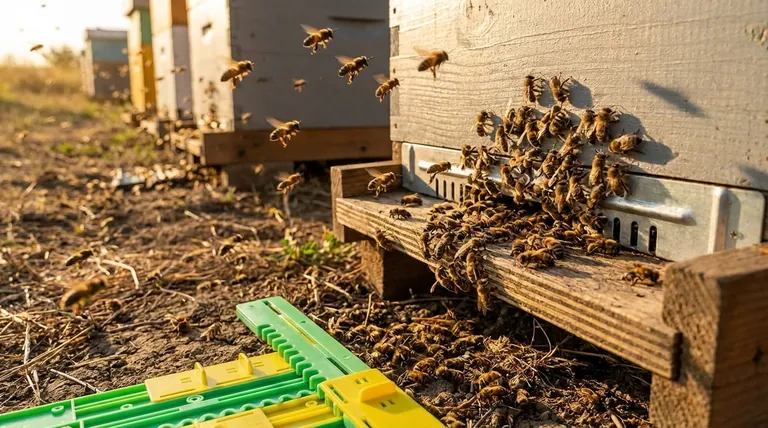The most critical signs of a robbing event are a chaotic, frantic cloud of bees at the hive entrance, widespread fighting between bees, and a significant number of dead bees on the ground. Unlike the purposeful flight of foragers, robbing bees fly erratically, darting from side to side and probing every crack and seam of the hive for a way inside.
Robbing is not normal foraging; it is a violent and desperate "feeding frenzy" where a stronger colony attacks and steals the honey stores from a weaker one. Recognizing the difference between this chaotic assault and regular hive traffic is the first step in saving a vulnerable colony.

Distinguishing Robbing from Normal Activity
A busy hive can be mistaken for a robbing event by an inexperienced beekeeper. However, the nature of the activity is fundamentally different. Understanding these differences is key to a correct diagnosis.
The Sound of Chaos
Normal foraging produces a steady, business-like hum. A robbing event is characterized by a high-pitched, frantic buzzing sound that signals aggression and panic.
The Nature of the Flight
Foraging bees fly with purpose, leaving and returning to the entrance in a clear flight path. Robbers, by contrast, hover erratically. They fly side-to-side, darting up and down as they search for any undefended opening.
Behavior at the Entrance
On a normal day, guard bees at the entrance will monitor incoming foragers. During a robbing event, you will see bees locked together, fighting and tumbling on the landing board and on the ground as the hive's guards try desperately to repel the intruders.
Key Visual Indicators of an Active Robbing Event
If you suspect robbing, look for these definitive visual cues that confirm an attack is in progress.
A Frenzy at the Entrance
Instead of an orderly flow of traffic, the hive entrance will be swarmed by a chaotic mob of bees. This looks less like a busy airport and more like a riot.
Increased Bee Fatalities
Defending a hive is a deadly business. You will see an unusual number of dead and dying bees on the landing board and on the ground in front of the hive. This is the clear result of widespread fighting.
Probing for Weaknesses
Robbing bees are relentless. They will not just focus on the main entrance but will actively probe any potential weakness, such as gaps between hive boxes, cracks in the wood, or the inner cover opening.
The Presence of Opportunists
Robbing creates chaos that attracts other pests. You will often see yellowjackets and other wasps joining the fray, taking advantage of the breached defenses to steal honey for themselves.
Signs After a Robbing Event
Sometimes the attack happens so quickly that you only see the aftermath. If you return to a suddenly quiet hive, an internal inspection is necessary.
Debris on the Bottom Board
A clear sign of a completed robbing is found on the bottom board. It will be littered with a large amount of chewed wax flakes. This is the debris left behind as the robbers violently tore open the sealed honey cappings. You may also find dead bees here.
A Depleted and Agitated Colony
If the colony survived, its population will be diminished, and its honey stores will be gone. The remaining bees will often be highly agitated, defensive, and demoralized.
Making the Right Diagnosis
Proper identification is crucial because the wrong response can make things worse. Observing the specific behaviors will tell you what you need to know.
- If your primary focus is confirming an active attack: Look for the combination of frantic, side-to-side flight and bees physically fighting and tumbling at the entrance.
- If your primary focus is determining if an attack already happened: Inspect the bottom board for an excessive amount of chewed wax cappings, a tell-tale sign of plundered honey.
Quickly and accurately identifying a robbing event is the most critical skill for protecting your hive from total collapse.
Summary Table:
| Situation | Key Signs to Look For |
|---|---|
| Active Robbing Event | Frantic, erratic bee flight; bees fighting and tumbling; high-pitched buzzing; dead bees on the landing board. |
| After a Robbing Event | Hive is suddenly quiet; bottom board littered with chewed wax flakes; honey stores depleted; remaining bees are agitated. |
| Normal Hive Activity | Steady, purposeful flight paths; a consistent, business-like hum; guard bees calmly monitoring foragers. |
Protect Your Apiary's Vital Honey Stores
A robbing event can devastate a colony and its honey production. Don't let your hard work be plundered. Equip your commercial apiary or distribution business with the right supplies to maintain strong, defensible hives.
HONESTBEE supplies beekeeping supplies and equipment to commercial apiaries and beekeeping equipment distributors through wholesale-focused operations. We provide the durable equipment and protective gear you need to manage hive health and prevent losses.
Contact our wholesale experts today to discuss your needs and secure your apiary's success.
Visual Guide

Related Products
- Multi-Functional Sliding Hive Entrance for Beekeeping
- HONESTBEE Advanced Ergonomic Stainless Steel Hive Tool for Beekeeping
- Professional Dual-End Stainless Steel Hive Tool for Beekeeping
- Professional Galvanized Hive Strap with Secure Locking Buckle for Beekeeping
- Beekeeping Gloves Goatskin Leather with Long Cotton Sleeve for Beekeepers
People Also Ask
- What additional functions do hive entrances serve? A Key to Colony Health, Security, and Productivity
- How does the sliding design of the entrance reducer benefit beekeepers? Achieve Ultimate Hive Control
- How do bees manage debris with a small hive entrance? A Guide to Strategic Hive Management
- How can a Langstroth hive entrance be adjusted? Mimic Natural Bee Preferences for a Healthier Hive
- Why is a smaller entrance size beneficial for a beehive? Boost Hive Defense & Productivity



















